unit 5人教版七年级英语下册 5单元教案
- 格式:docx
- 大小:41.93 KB
- 文档页数:7
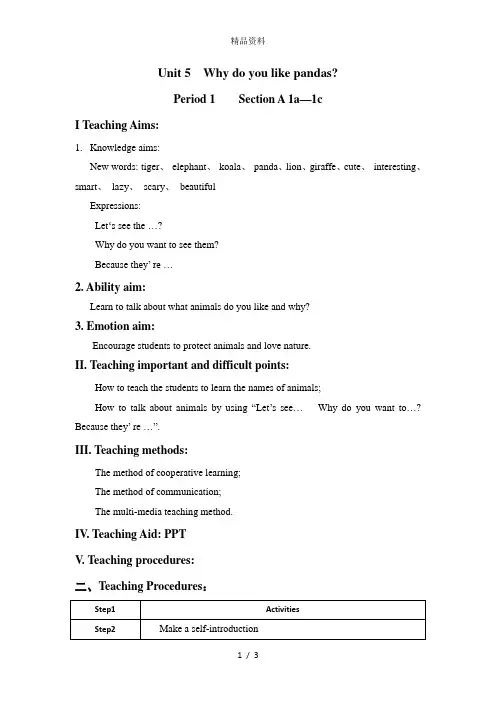
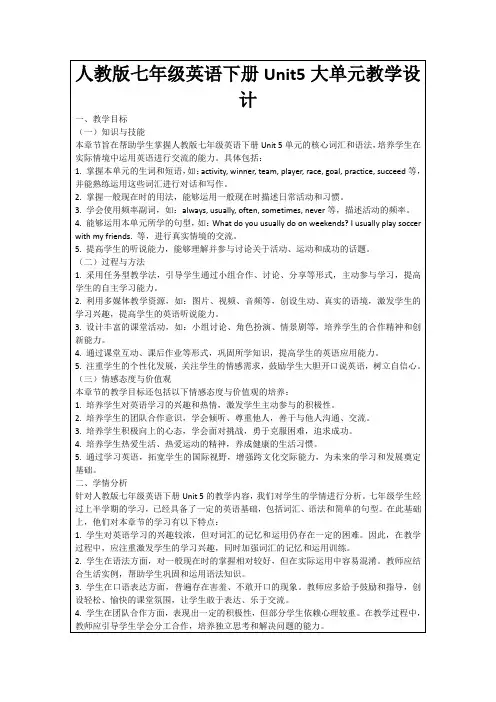

人教版新目标七年级英语下册 Unit 5 教案一. 教材分析人教版新目标七年级英语下册Unit 5主要讲述了日常生活中的一些活动,如游泳、打篮球、跳舞等。
本单元的话题贴近学生的生活,有利于激发学生的学习兴趣。
教材通过听说读写等多种活动,帮助学生掌握日常生活中的交际用语,提高学生的语言运用能力。
二. 学情分析七年级的学生已经掌握了基本的英语语法和单词,对于日常生活中的交际用语也有了一定的了解。
但部分学生可能在发音和口语表达上还存在困难,需要教师在教学中加以引导和纠正。
此外,学生可能对一些体育活动相关的词汇和表达不够熟悉,需要在课堂上进行拓展和练习。
三. 教学目标1.知识目标:学生能够掌握本单元的生词和短语,了解日常生活中的交际用语。
2.能力目标:学生能够听懂、会说、会读、会写与日常生活相关的英语句子。
3.情感目标:学生能够积极参与课堂活动,提高学习英语的兴趣。
四. 教学重难点1.重点:本单元的生词和短语,日常生活中的交际用语。
2.难点:情态动词can的用法,以及与日常生活相关的句型结构。
五. 教学方法1.任务型教学法:通过设置各种任务,让学生在完成任务的过程中学习英语。
2.情景教学法:创设各种生活情境,让学生在真实的环境中学习英语。
3.交际法:鼓励学生积极参与课堂交际,提高口语表达能力。
六. 教学准备1.准备单词卡片、短语卡片、图片等教学辅助材料。
2.准备与本单元话题相关的视频或音频材料。
3.准备课堂练习题和测试题。
七. 教学过程1.导入(5分钟)利用图片或视频引导学生谈论日常生活中喜欢的活动,引出本课话题。
2.呈现(10分钟)老师展示本课的生词和短语,让学生朗读并解释其意思。
同时,老师用情态动词can提问,引导学生回答。
3.操练(15分钟)学生分角色扮演,用情态动词can进行问答。
老师巡回指导,纠正发音和表达错误。
4.巩固(10分钟)学生完成课堂练习题,老师及时批改和讲解。
5.拓展(5分钟)老师引导学生谈论更多关于日常活动的表达,如游泳、打篮球、跳舞等。
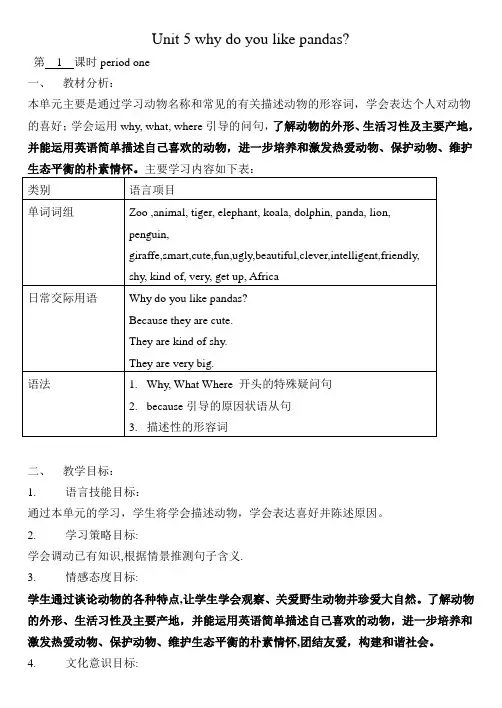
Unit 5 why do you like pandas?
第1课时period one
一、教材分析:
本单元主要是通过学习动物名称和常见的有关描述动物的形容词,学会表达个人对动物的喜好;学会运用why, what, where引导的问句,了解动物的外形、生活习性及主要产地,并能运用英语简单描述自己喜欢的动物,进一步培养和激发热爱动物、保护动物、维护生态平衡的朴素情怀。
主要学习内容如下表:
二、教学目标:
1.语言技能目标:
通过本单元的学习,学生将学会描述动物,学会表达喜好并陈述原因。
2.学习策略目标:
学会调动已有知识,根据情景推测句子含义.
3.情感态度目标:
学生通过谈论动物的各种特点,让学生学会观察、关爱野生动物并珍爱大自然。
了解动物的外形、生活习性及主要产地,并能运用英语简单描述自己喜欢的动物,进一步培养和激发热爱动物、保护动物、维护生态平衡的朴素情怀,团结友爱,构建和谐社会。
4.文化意识目标:
了解各种动物的特性及它们的分布点。
第2课时
第3课时
第4课时
第5课时
第6课时
第7课时。

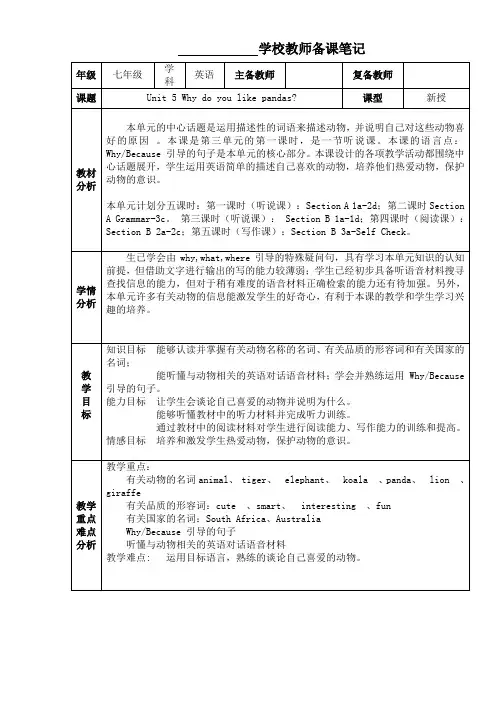
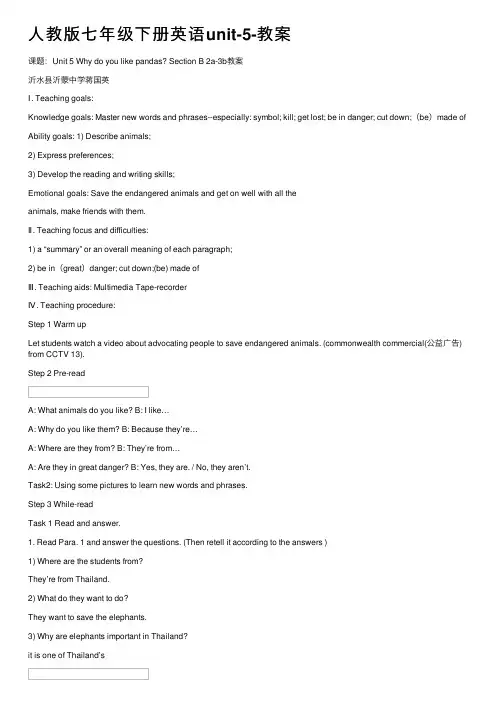
⼈教版七年级下册英语unit-5-教案课题:Unit 5 Why do you like pandas? Section B 2a-3b教案沂⽔县沂蒙中学蒋国英Ⅰ. Teaching goals:Knowledge goals: Master new words and phrases--especially: symbol; kill; get lost; be in danger; cut down;(be)made of Ability goals: 1) Describe animals;2) Express preferences;3) Develop the reading and writing skills;Emotional goals: Save the endangered animals and get on well with all theanimals, make friends with them.Ⅱ. Teaching focus and difficulties:1) a “summary” or an overall meaning of each paragraph;2) be in(great)danger; cut down;(be) made ofⅢ. Teaching aids: Multimedia Tape-recorderⅣ. Teaching procedure:Step 1 Warm upLet students watch a video about advocating people to save endangered animals. (commonwealth commercial(公益⼴告) from CCTV 13).Step 2 Pre-readA: What animals do you like? B: I like…A: Why do you like them? B: Because they’re…A: Where are they from? B: They’re from…A: Are they in great danger? B: Yes, they are. / No, they aren’t.Task2: Using some pictures to learn new words and phrases.Step 3 While-readTask 1 Read and answer.1. Read Para. 1 and answer the questions. (Then retell it according to the answers )1) Where are the students from?They’re from Thailand.2) What do they want to do?They want to save the elephants.3) Why are elephants important in Thailand?it is one of Thailand’s.Because Thailand’s first flag had on it.It’s a symbol of .2. Read Para. 2 and answer the questions. (Then retell Para. 2)1) Are elephants smart animals?2) What can they do?can or .can also very well.can for a long time and never .can also places with food and water.3. Read Para.3 and answer the questions. (Then retell Para. 3)1) Are elephants in great danger? And why?Elephants are _______________.People many trees so elephants are losing Because People kill elephants forToday there are only about elephants.( over before) 2) How can they save elephants? (and)D on’t cut down so many .Don’t things made of ivoryRemember that March 13th is _____________________.TheyTask 2 Read and match.Para.1 What can elephants do?Why are elephants in danger and how can they save them?Para.3 Elephants are important in Thailand.Task 3 Read and check: Which is the best title for 2b?What Is an ElephantCome to ThailandLet ’s Save the ElephantsElephants Are Good PetsTask 4 listen and read.1. Listen to the tape.2. Read the passage aloud.Step 4 Post-readTask 1 Summary.1. Complete the English sentences according to the Chinese. 根据汉语完成英语句⼦。

Unit 5 Why do you like koalas?一、考点、热点回顾【重点单词】__________ adj、可爱得,机灵得__________ adj、懒惰得__________ adj、聪明得__________adj、美丽得,美好得__________ n、种类__________v & n、睡觉__________adj、友好得__________ adj、害羞得___________ v、拯救__________ v、忘记,遗忘__________ n、危险___________ prep、超过,多于【重点短语】________ 有点,稍微____________ 整天_________ 很,非常_________ 对…友好________ …中之一_____________ 处于危险之中____________ 砍到【重点句型】1.让我们去瞧熊猫吧。
____________ __________ the pandas___________、2.您为什么想瞧它们?_________ do you _________ _________ see them ?3.我非常喜欢老虎。
I _________ tigers __________ __________、4、难道她不美丽吗?__________ she ___________ ?【重点语法】:形容词与疑问副词why得用法(1)、形容词得概念形容词表示人或事物得性质,特征,特点等(2)、形容词得位置形容词作定语修饰名词时,要放在名词得前面eg:I have a lovely dog、但就是如果形容词修饰something, anything, nothing等不定代词时,要放在这些不定代词得后面。
如: There is something wrong with the bike、这辆自行车出毛病了。
(3)、形容词得用法除了可以作定语、表语、宾语补足语以外,有些形容词还可以与定冠词连用,表示一类人或事物,这时,它相当于一个名词,可以作主语或宾语。
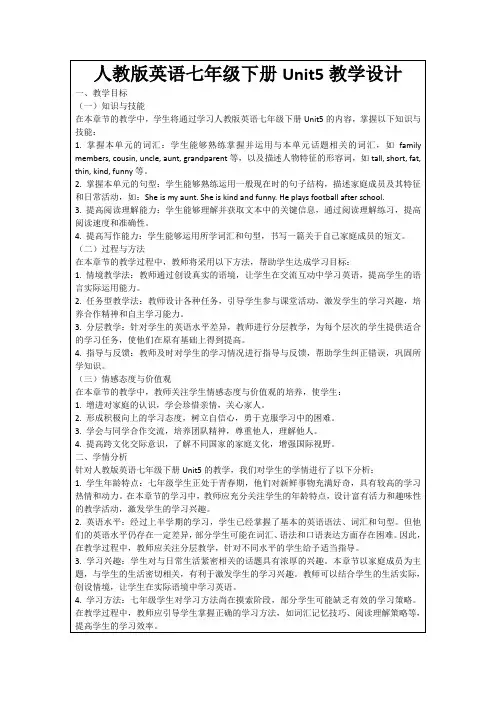
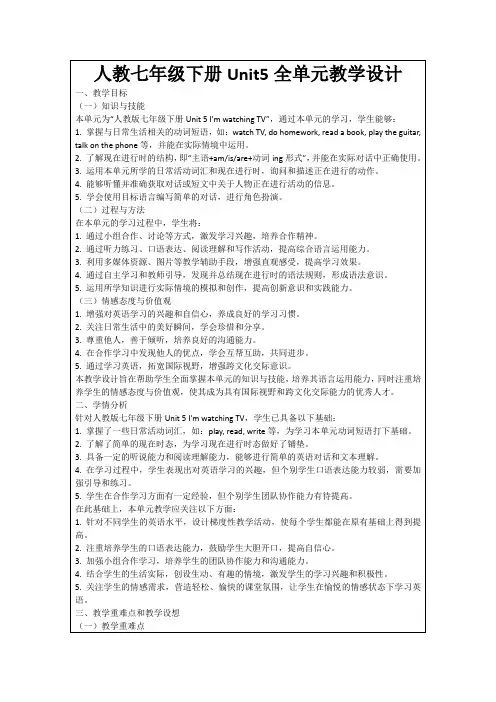

人教版新目标七年级英语下Unit5教案Unit 5 I’m watching TV第1课时一、学习目标1. 会读写25-26页单词2. 掌握句型-What are you/ they doing? -I’m / They’re watching TV.-What is she/he doing? -She /He is doing homework..3. 会用现在进行时谈论自己及别人正在做某事二、学习重点1. 学会用现在进行时的特殊疑问句来询问及回答自己及某人正在做某事2. 学会用现在进行时的一般疑问句来询问及回答自己及某人是否正在做某事三、学习过程(一)课前准备1.自己预习25-26页的单词和句子,不懂得地方做上标记,以便课上与同学们进行交流。
2.试做新方案36页课堂练习部分。
(二) 课堂活动1. 看1的图片和单词,把单词和图片搭配。
2. 听录音,完成1的听力。
3. 同学们分角色练习听力中的对话。
4. 学习成果展示:小组谈论某人正在做某事。
5. 再练习两个听力22练习,完成听力对话的内容。
6. 看2中的例句,仿造现在进行时的一般疑问句及回答。
7. 学习成果展示:两人用一般现在进行时的问句进行问答。
(三) 课堂练习1. What ______ you ______ (do) now?2. I’m _________ (eat) dinner .3. Look! What ______ Nancy______ (do)?4. She is _________ (write) a letter.5. Listen! What _________ they________(do)?四、学后反思本节课我学会了:我在学习中遇到的问题是:五、课后作业Unit 5 I’m watching TV第2课时一、学习目标1.讨论日常活动2.重点词组go to the movies去看电影write a letter 写一封信reading a book 看书3.目标用语1)-What are you doing? -I’m watching TV.2)-What’s she doing?-She’s read ing.二、学习重点现在进行时的用法三、学习过程(一)课前准备写出下列动词的现在分词1. do______2. watch ______3. write _____4. read ____5. take_____6. wait_____7. talk_____ 8. stop ______写出下列短语:⒈做作业___________ 2.去看电影_______________ 3.读书______________4.等待 ____________5.和某人谈话 _____________6.谈论 _____________(二)课堂活动【新课导入】复习目标语,为新课做准备。
人教版七年级英语下册Unit5教学设计Why do you like pandas?Section B(2a~2c)教材分析:This lesson is from Unit5Why do you like pandas?It's the second lesson in section B.And it's a reading lesson. It mainly exercises students5reading ability.This lesson focuses on the situation of elephants.This subject has a wide range of knowledge and interest,which can arouse students5interest in reading.学情分析:The students in the second semester of the seventh grade have already possessed a certain initial ability of English listening,speaking,reading and writing,reserve a certain amount of English vocabularies,have established the awareness of English learning,have a strong initial strength, can actively participate in classroom activities,and are happy to express themselves.They are lively and active.But some students with weak foundations in the class fail to keep up.So this class is to strengthen the students5basic abilities of reading and writing.教学目标:1.Describe animals and express preferences.2.Improve their speaking and reading skills in the process of group cooperation.3.Understand and master the sentence structures with “Why,What,Where questions”・4.Improve the ability to think independently and make them dare to express,stimulate interest in learning English in activities.cate students to protect the wild animals.教学重难点:Teaching Key Points:1.Learn and master the usage of the sentence structures.2.Learn to describe animals and express preferences.Teaching Difficult Points:Learn to describe animals and express preferences.教学过程:Activity1:Pre-reading1.Lead in:Watch a video about elephants and ask questions:A.Do you like the elephants?B.What do you think of the elephants?C.Do you know about them?2.Show some pictures to let students know more about them.Activity2:While-readingTask1ScanningLook through the article and answer the following question:What kind of passage is it?Task2Fast ReadingLook through the article and check(V)the best title.Task3SkimmingLook through the article and find the main idea of each paragraph.Task4Careful Reading1.Read paragraph1and answer the following question:Which one is the first flag of Thailand?2.Read paragraph2and answer the following question:What can elephants do?3.Read paragraph3and answer the following questions:A.What do people do with elephants?B.How many elephants are there?Activity3:Post-reading1.Group WorkWork in groups of four and discuss the following question:How can we save the elephants?2.Watch a video to learn China's actions.SummaryReview this class and finish the mind map.HomeworkSearch more information on the Internet about the endangered animals and write a composition to call on people to protect them,(about80words)教学反思:The highlight of this lesson is to show the videos about elephants,so that students can know about it before class, and stimulate students5strong interest in learning.The disadvantage is that due to the limited time,some aspects of the process are relatively rough.Generally speaking,the children in this class are active in thinking and able to follow the teacher5s thoughts closely.I also enjoy it very much.。
Unit5 Why do you like pandas?Period 1 Section A(1a-2c)Teaching aims:1. Know the words about animals and their personalities.2. Enable the students to talk about and describe their favorite animals.3. Educate the students to love and protect animals.Key points:1. Master these words: zoo, animals, panda, tiger, elephant, koala, lion, giraffe, cute,beautiful, smart, lazy, scary, kind of, South Africa, Australia.2. Master the following sentence patterns:------ Why do you/don’t you like …?Why does /doesn’t he /she like …?Because they are …------ Where are … from?They are from …Teaching aids: a tape recorder, pictures, ppt.Teaching steps:Step One GreetingsSay Hello to the students.Step Two Lead-inPlay a short video for the students. What animals do you know?Step Three Presentation1. Teach new words with pictures.2. Present the following sentences with pictures.Why do you/don’t you like …?Because they are …Step Four ListeningPlay the recorder and ask students to do activity 1b.Step Five pair work.Show some pictures and a sample dialogue to the students, then ask them to make more conversations and act them out.A: Let’s see the lions.B: Why do you want to see them?A: Because they are interesting.cute interesting funsmart beautiful friendly shy…Step Six Work in groups. Ask and answerShow a sample dialogue to the students, then ask them to make more conversations and act them out.A:I like dogs. B:Why do you like dogs?A:Because they are cute and friendly.B: What animals does she like? Why does she like them?A:She likes panadas. Because they’re cuteStep 7 Listening1. Listen and complete 2a. Play the recorder twice, for the first time , students findout the animals they hear. Then they guess the description words and countries.Next, play the recorder for the second time and students to make sure theanswers.2. Listen and complete 2b.Step Seven Pair work1.Present a map of the world to teach new words and the new sentence pattern“Where are they from?”“They are from…”2. Show some pictures of animals and have students make conversations with thefollowing sentences:A: Let’s see…Do you like …? B:Yes, I do./ No, I don’t.A: Why do you/ don’t you like them? B: Because they are… .A: Where are they from? B: They are from… .3. Ask several pairs to show their conversations.Step Eight Survey1. Ask students to work in groups and do a survey.2. Fill in the chart about the survey .3. Ask students to do a report about their survey results.Step Nine Homework1. Make a list of the animals you know and try to describe each animal with a wordwe learnt in this class.2. Write an article about your favorite animals and describe their appearances, personalities, food, hobbies and where they are from.Period 2 Section A (1a-2c)Teaching aims:1. Know the words about animals and their personalities.2. Enable the students to talk about and describe their favorite animals.3. Educate the students to love and protect animals.Key points:1. Master these words: pet, leg, cat, sleep.2. Master the following sentence patterns:Why do you like pandas?Becau se they’re kind of interesting.Why does John like koalas?Because they’re very cute.Why don’t you like tigers?Why don’t you like tigers?Where are lions from?They’re from South Africa.Teaching procedures:Step 1: Review.1.Review the words: chant.2. Where are the animals from?Step 2 Work on 2d. Role-play.1.T: Some people like animals very much.They keep (=have养)an animal athome. We call the animals that we keep at home pets. (pet, cat,leg, sleep) T: What pets do people keep?2. Fast reading. Read the conversation and answer the questions.(1). What pet does Peter have?(2). What pet does Jenny’s mother have?3.Careful reading. Read again and answer the questions.(1). Does Peter like his dog?(2). What can the dog do?(3). Does Jenny like her mother’s pet? Why or Why not?4. Then Ss read the conversation in 2d5. Let some pairs role-play the conversation in 2d.Step 3 Grammar Focus.1.学生阅读Grammar Focus中的句子,然后做填空练习。
人教版七年级下册英语unit5整体单元教学设计English:In Unit 5 of the seventh grade English textbook of People's Education Press, the overall theme is "Celebrations". The unit integrates language points and communication tasks related to various celebrations, such as birthdays, New Year's Day, and cultural festivals. The unit aims to help students understand and use vocabulary related to celebrations, recognize and interpret simple written and spoken materials related to celebrations, and produce short written and spoken texts related to celebrations. The unit also focuses on developing students' abilities in listening, speaking, reading, and writing, as well as promoting their intercultural awareness and communication skills.中文翻译:在人教版七年级英语教材下册的第五单元中,整体主题是“庆祝活动”。
该单元整合了与生日、新年和各种文化节日等庆祝活动相关的语言要点和交际任务。
该单元旨在帮助学生理解和使用与庆祝活动相关的词汇,认识和解释与庆祝活动相关的简单书面和口头材料,并产生与庆祝活动相关的简短书面和口头文本。